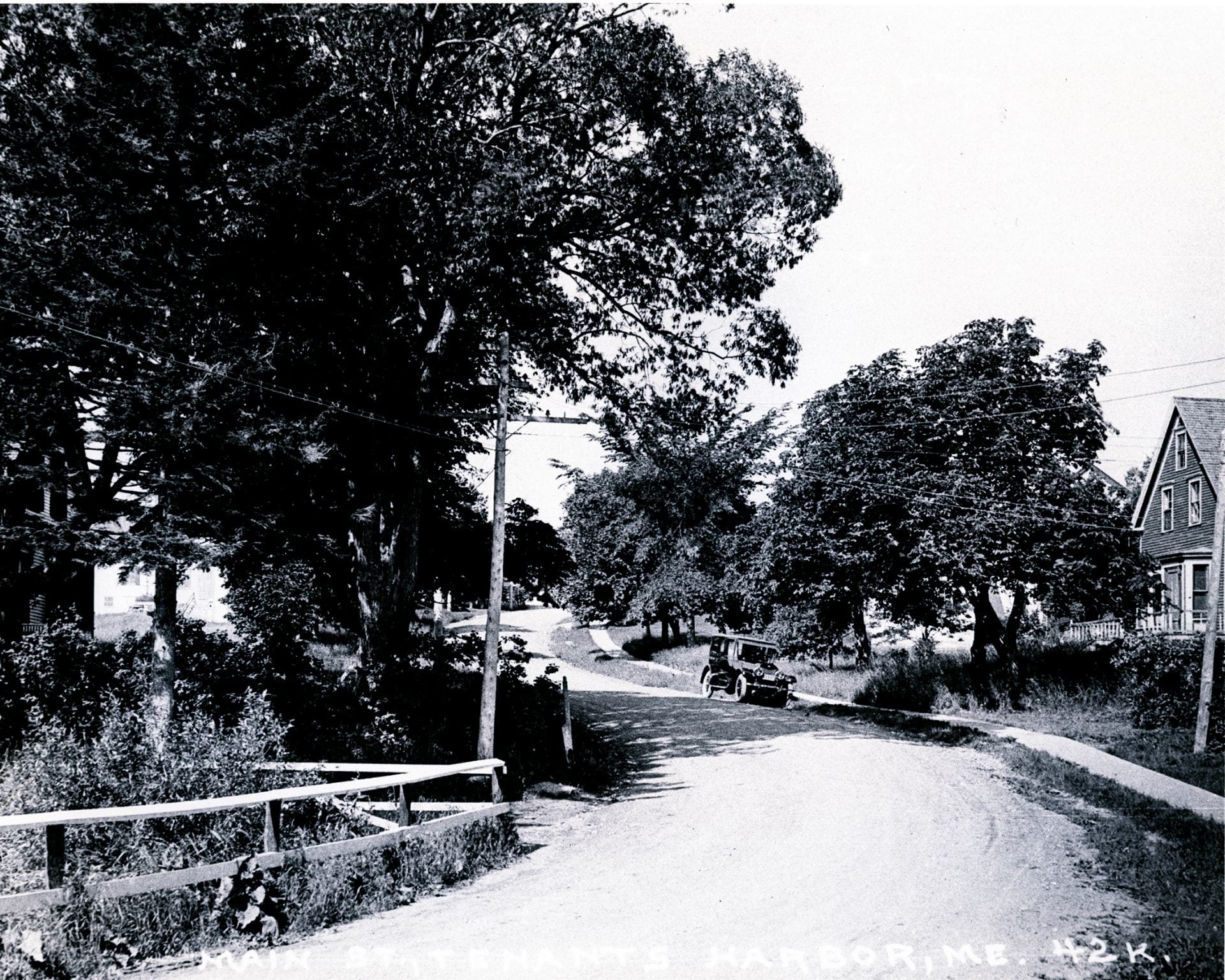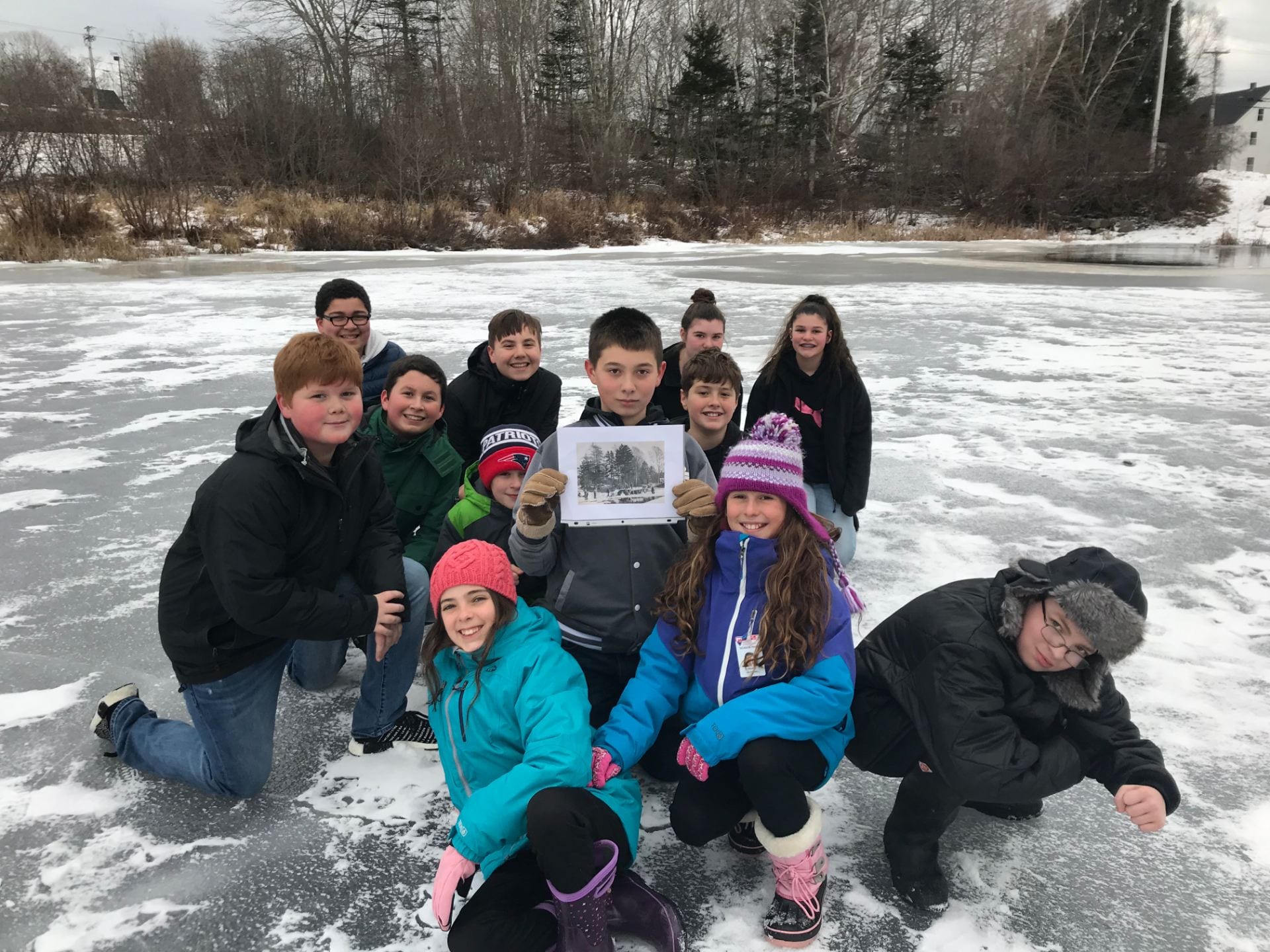Contributed by Leilani Myers, Anna Hooper, Madisyn Morris, Hayzel Poland, Isla Mitchell, Ella Cushman and Brooke Hoppe.
Following John Falla’s classroom visit, students did some writing about the images and information he shared that helped us understand how the stream became a marsh.

View of the marsh, circa 1930’s – 1940’s
Leilani Myers writes: “This picture was taken in the between the 1930’s and 1940’s. It was taken over the bank on the marsh, where there are now scrubby little bushes. It shows the marsh, the field where the library now stands, and the tip of the point on the marsh trail. The pine trees on the far right and in the background on the edge of the field are no longer here.
It makes me want to learn more about how the landscape has changed over the years and what caused it to change. Mr. Falla talked about the changing water levels. The photo seems to have more water and the point of the trail is a lot smaller than it does now. The water level would affect the alewives that live and come to spawn in the marsh, and if it gets too low, they won’t be able to travel to and from the marsh anymore, which would mean no more baby alewives, and in the long run, no more ALEWIVES!!!
I like all the trees in the photo, and that there are no buildings or signs of civilization anywhere. I would like to print this photo out and go down to the marsh, to compare it to the marsh now.
Thank you Mr.Falla, for teaching us about the Marsh and its history!”

Ice cutting in the 1940’s
Anna Hooper writes: “I chose this image because it seems interesting and I want to learn more about it. In the image they are cutting the ice for the icehouse. They also use the ice for shipping the fish away. This image was taken in the 1940’s at the marsh and it looks a lot different than now. They were able to cut the ice in the 1940’s because the water level was higher than it is now. In another picture we saw the ice house near the marsh.
Knowing that the level of the water is lower and the tide can come in makes us wonder if this is why there are fewer alewives. Thank you Mr. Falla for coming in and talking about the marsh and what your experience. Now I would like to know more about the marsh.”
Madisyn Morris writes: “I think this image looks interesting. The reason I think the picture is interesting is because people don’t do this anymore….The ice was also very important because people had ice boxes before refrigerators. Everyone in the town needed the ice to keep their food stored safely. The Davis brothers probably made money too.”

Artist rendering of the Marsh and the Davis Bros. Ice House, circa 1900 – 1910
Hayzel Poland writes: “This is a painting of the marsh that was made in the 1900’s. When it was the 1900’s the marsh had an “icehouse” that is in the top right corner of this painting. A family business named the Davis Brothers used to take chunks of ice and put it in the icehouse. The Davis Brothers had an ice business, but in order to do that they had to get permission from all the local landowners whose property was near the marsh that would overflow, so they could make a dam in the marsh at the outlet…It is surprising how much has changed from then and now. There were different water levels, and there is no more icehouse, but the rock that is seen in this painting is still here to this very day.”
Isla Mitchell adds, “The thing I like about the photo is it reminds me of the ice pond on Monhegan Island.”
Ella Cushman also notes: “The icehouse in the picture is where the library in Tenants Harbor is right now, so when you start to think about that, it was around 100 years ago…Twenty-five years after this picture both of my great grandmas were born, and I was born in 2006. I wonder what it will be like 100 years from now.”

Main St. in Tenants Harbor, 1910
Brooke Hoppe writes: “This is a picture that was taken in 1910 of the road alongside the stream from the marsh. Today, this is still the exact same spot where the culvert is. The house to the right of the picture is still there too. Some differences from the picture and what it looks like today are the road and the sidewalks. In the picture, the road looks like a dirt road, but currently, the road is paved. The sidewalks in the picture are wooden planks, but now the sidewalks are concrete. Also, the big trees in front of the house to the right aren’t there anymore.
What comes to my mind when I look at this picture is how it still looks very similar to today. I think it’s cool how the car is in this photo because it gives you a better idea of how long ago it was. This picture was taken over 100 years ago. Just imagine what it’s going to look like one hundred years from today!
Thank you to Mr. Falla for coming into our classroom and telling us about some history of St. George and the marsh.”

Main St. Tenants Harbor, 2019
Our “Now and Then” images!

View from the back of the parking area, 2019

This photo is all about the rocks! These rocks on the lower right are the only sign of what remains the same from the photo that follows! The two houses were removed in the 1960’s.

All that remains from the house on the left is the foundation pillar in the stream today. Both houses were torn down in the 1960’s. Their site is today’s parking area for marsh access.

In 2019 we are re-creating the shot of the ice cutting activity of the 1940’s image (see above)!







